Higher classification Coracias | Family Coraciidae Scientific name Coracias benghalensis Rank Species | |
 | ||
Similar Bird, Roller, Coracias, Red‑wattled lapwing, Green bee‑eater Scientific name Coracias benghalensis Conservation status Least Concern Mass 160 g (Adult) | ||
Indian roller bird a beautiful close up view
The Indian roller (Coracias benghalensis), is a member of the roller family of birds. They are found widely across tropical Asia from Iraq eastward across the Indian Subcontinent to Indochina and are best known for the aerobatic displays of the male during the breeding season. They are very commonly seen perched along roadside trees and wires and are commonly seen in open grassland and scrub forest habitats. It is not migratory, but undertakes some seasonal movements. The largest populations of the species are within India, and several states in India have chosen it as their state bird.
Contents
- Indian roller bird a beautiful close up view
- Taxonomy and systematics
- Subspecies
- Description
- Distribution and habitat
- Ecology and behaviour
- In culture
- References
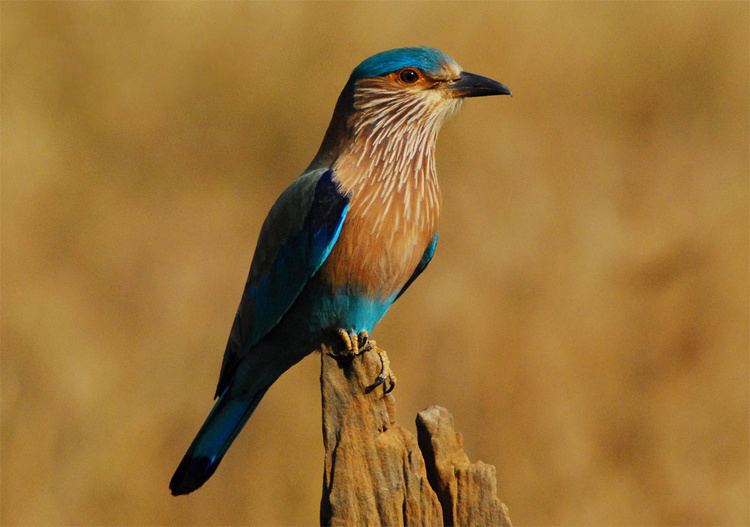
Taxonomy and systematics
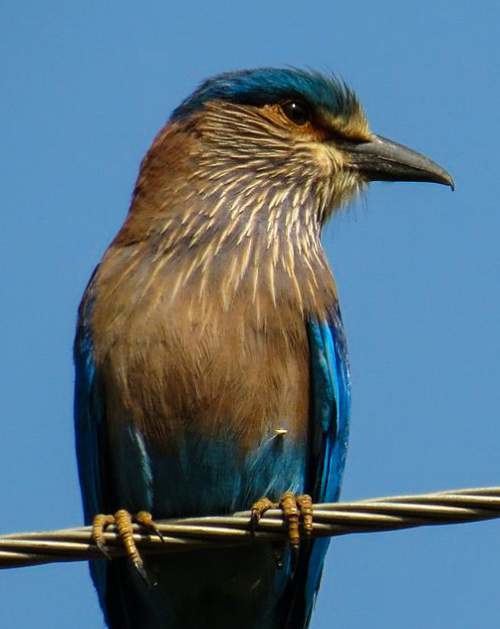
The Indian roller was originally described as belonging to the genus Corvus. Alternate names for the Indian roller include the Indian blue roller, northern roller and southern blue roller.
Subspecies
Three subspecies are recognized:
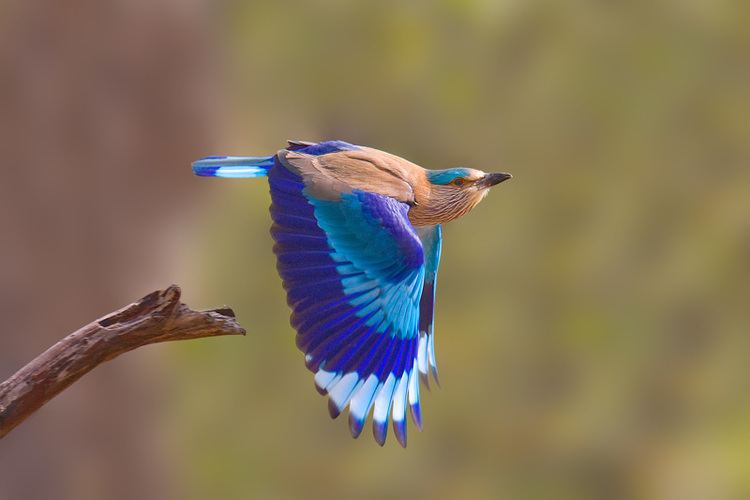
Description

The Indian roller is a stocky bird about 26–27 cm long and can only be confused within its range with the migratory European roller. The breast is brownish and not blue as in the European Roller. The crown and vent are blue. The primaries are deep purplish blue with a band of pale blue. The tail is sky blue with a terminal band of Prussian blue and the central feathers are dull green. The neck and throat are purplish lilac with white shaft streaks. The bare patch around the eye is ochre in colour. The three forward toes are united at the base. Rollers have a long and compressed bill with a curved upper edge and a hooked tip. The nostril is long and exposed and there are long rictal bristles at the base of the bill.
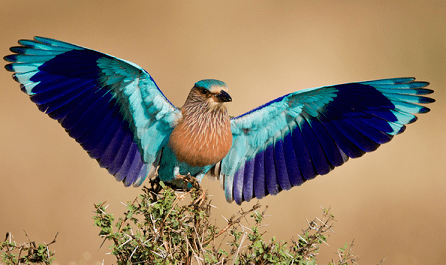
Three subspecies are usually recognized. The nominate form is found from western Asia (Iraq, Arabia) east across the Indian Subcontinent, and within India north of the Vindhyas mountain ranges. The subspecies indicus is found in peninsular India and Sri Lanka. The southern form has a darker reddish collar on the hind neck which is missing in the nominate form. The race affinis of northeastern India and Southeast Asia (Thailand, Myanmar, Indochina) is sometimes considered a full species, but within the Indian region, it is seen to intergrade with benghalensis. The form affinis is darker, larger and has a purplish brown and unstreaked face and breast. It has underwing coverts in a deeper shade of blue.
Distribution and habitat

The Indian roller is distributed across Asia, from western Asia (Iraq), through the Indian Subcontinent (including Sri Lanka and the islands of Lakshadweep and the Maldive Islands) into Southeast Asia.
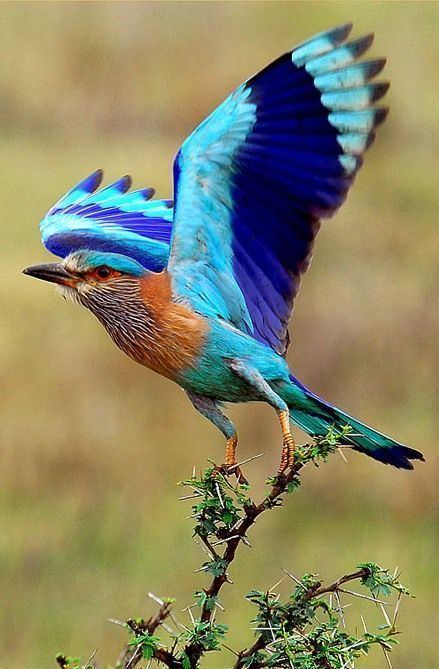
The main habitat is cultivated areas, thin forest and grassland. They are often seen perched on roadside electric wires.
Ecology and behaviour
These birds are usually seen perched on prominent bare trees or wires. They descend to the ground to capture their prey which may include insects, arachnids, small reptiles (including Calotes versicolor and small snakes and amphibians. Fires attract them and they will also follow tractors for disturbed invertebrates. In agricultural habitats in southern India, they have been found at densities of about 50 birds per km2. They perch mainly on 3—10 metre high perches and feed mostly on ground insects. Nearly 50% of their prey are beetles and 25% made up by grasshoppers and crickets. The feeding behaviour of this roller and habitat usage are very similar to that of the black drongo. During summer, they may also feed late in the evening and make use of artificial lights and feed on insects attracted to them. They are attracted to swarms of winged termites and as many as 40 birds have been seen to perch on a 70-metre stretch of electric wires. Their habit of feeding near roadsides sometimes results in collisions with traffic. A decline in the numbers of these birds seen along roadsides in northern India has been noted.
The display of this bird is an aerobatic display, with the twists and turns that give this species its English name. The breeding season is March to June, slightly earlier in southern India. Displays when perched include bill-up displays, bowing, allopreening, wing drooping and tail fanning. Holes created by woodpeckers or wood boring insects in palms are favoured for nesting in some areas. Nest cavities may also be made by tearing open rotten tree trunks or in cavities in building. The cavity is usually unlined and is made up mainly of debris from the wood. The normal clutch consists of about 3-5 eggs. The eggs are white and broad oval or nearly spherical. Both sexes incubate the eggs for about 17 to 19 days. The young fledge and leave the nest after about a month. Nearly 80% of the eggs hatch and fledge.
The call of the Indian roller is a harsh crow-like chack sound. It also makes a variety of other sounds, including metallic boink calls. It is especially vociferous during the breeding season.
The bird bathes in open water by plunge-diving into it, a behaviour often interpreted as fishing. But it may occasionally attempt fishing from water.
Blood parasites Leucocytozoon of the family Plasmodiidae have been noted in the lung tissues. Parasitic helminth worms Hadjelia truncata and Synhimantus spiralis were recorded as well.
In culture
The Indian roller is very common in the populated plains of India and associated with legends. It is said to be sacred to Vishnu, and used to be caught and released during festivals such as Dussera and Durga Puja. A local Hindi name is neelkanth, meaning "blue throat", a name associated with the deity Shiva (who drank poison resulting in the blue throat).
The Indian roller is known locally in Telugu as 'pala pitta' and in Kannada as 'neelakanthi'. There is a traditional belief that chopping its feathers and mixing them with grass to feed to cows can enhance milk production. The Indian roller is recognized as the state bird by several Indian states, including Andhra Pradesh, Odisha, Karnataka, and Telangana.
